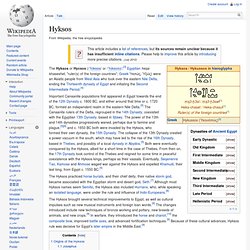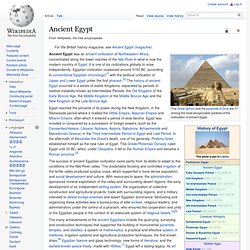

Hyksos. The Hyksos or Hycsos (/ˈhɪksɒs/ or /ˈhɪksoʊz/;[3] Egyptian heqa khaseshet, "ruler(s) of the foreign countries"; Greek Ὑκσώς, Ὑξώς) were an Asiatic people from West Asia who took over the eastern Nile Delta, ending the Thirteenth dynasty of Egypt and initiating the Second Intermediate Period.[4] Important Canaanite populations first appeared in Egypt towards the end of the 12th Dynasty c. 1800 BC, and either around that time or c. 1720 BC, formed an independent realm in the eastern Nile Delta.[5] The Canaanite rulers of the Delta, regrouped in the 14th Dynasty, coexisted with the Egyptian 13th Dynasty, based in Itjtawy.

The power of the 13th and 14th dynasties progressively waned, perhaps due to famine and plague,[5][6] and c. 1650 BC both were invaded by the Hyksos, who formed their own dynasty, the 15th Dynasty. Origins of the Hyksos[edit] There are various hypotheses as to the Hyksos' ethnic identity. Most archaeologists[who?] As to a Hyksos “conquest”, some archaeologists[who?] Second Intermediate Period of Egypt. The Second Intermediate Period marks a period when Ancient Egypt fell into disarray for a second time, between the end of the Middle Kingdom and the start of the New Kingdom.

It is best known as the period when the Hyksos made their appearance in Egypt and whose reign comprised the Fifteenth dynasty. End of the Middle Kingdom[edit] The brilliant Egyptian twelfth dynasty came to an end at the end of the 19th century BC with the death of Queen Sobekneferu (1806–1802 BC).[1] Apparently, she had no heirs, causing the twelfth dynasty to come to a sudden end as did the Golden Age of the Middle Kingdom, which was succeeded by the much weaker thirteenth dynasty of Egypt. Retaining the seat of the twelfth dynasty, the thirteenth dynasty ruled from Itjtawy ("Seizer-of-the-Two-Lands") near Memphis and el-Lisht, just south of the apex of the Nile Delta.
The thirteenth dynasty is notable for the accession of the first formally recognised Semitic king, Khendjer. Fifteenth dynasty[edit] References[edit] History of ancient Egypt. The history of Ancient Egypt spans the period from the early predynastic settlements of the northern Nile Valley to the Roman conquest in 30 BC.

The Pharaonic Period is dated from around 3200 BC, when Lower and Upper Egypt became a unified state, until the country fell under Greek rule in 332 BC. Chronology[edit] Note For alternative 'revisions' to the chronology of Egypt, see Egyptian chronology. Egypt's history is split into several different periods according to the ruling dynasty of each pharaoh. Predynastic Period (Prior to 3100 BC)Protodynastic Period (Approximately 3100–3000 BC)Early Dynastic Period (1st–2nd Dynasties)Old Kingdom (3rd–6th Dynasties)First Intermediate Period (7th–11th Dynasties)Middle Kingdom (12th–13th Dynasties)Second Intermediate Period (14th–17th Dynasties)New Kingdom (18th–20th Dynasties)Third Intermediate Period (21st–25th Dynasties) (also known as the Libyan Period)Late Period (26th–31st Dynasties) Ancient Egypt. Ancient Egypt was an ancient civilization of Northeastern Africa, concentrated along the lower reaches of the Nile River in what is now the modern country of Egypt.

It is one of six civilizations globally to arise independently. Egyptian civilization coalesced around 3150 BC (according to conventional Egyptian chronology)[1] with the political unification of Upper and Lower Egypt under the first pharaoh.[2] The history of ancient Egypt occurred in a series of stable Kingdoms, separated by periods of relative instability known as Intermediate Periods: the Old Kingdom of the Early Bronze Age, the Middle Kingdom of the Middle Bronze Age and the New Kingdom of the Late Bronze Age. History Map of ancient Egypt, showing major cities and sites of the Dynastic period (c. 3150 BC to 30 BC) Predynastic period A typical Naqada II jar decorated with gazelles. In Predynastic and Early Dynastic times, the Egyptian climate was much less arid than it is today.